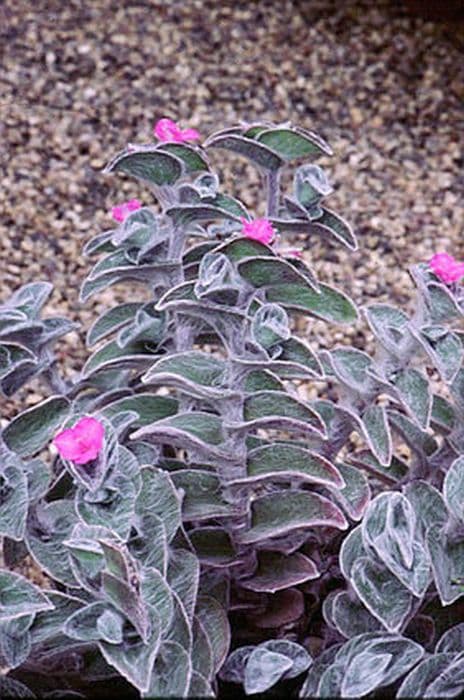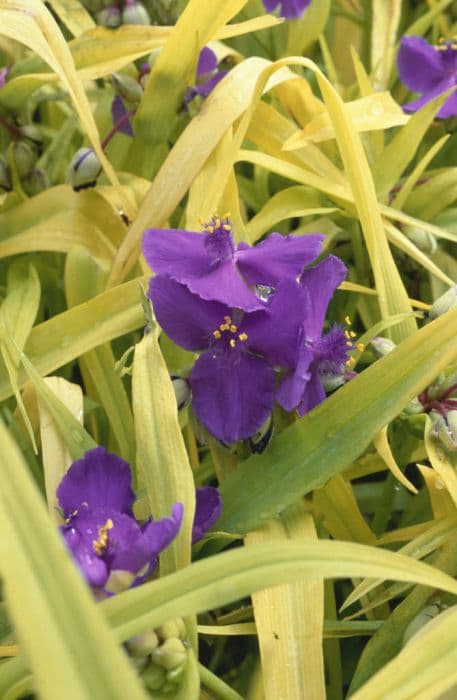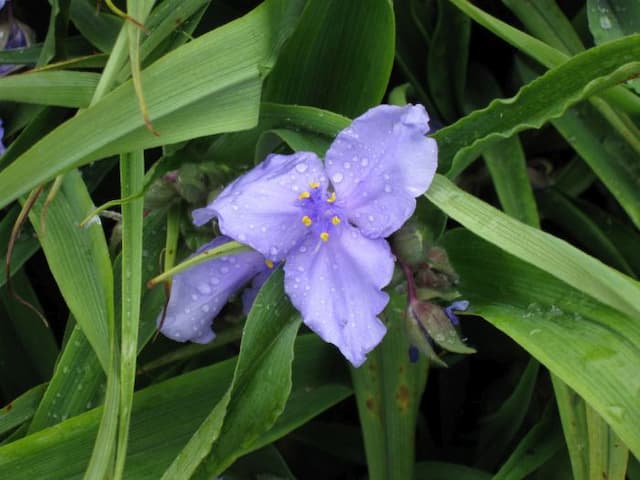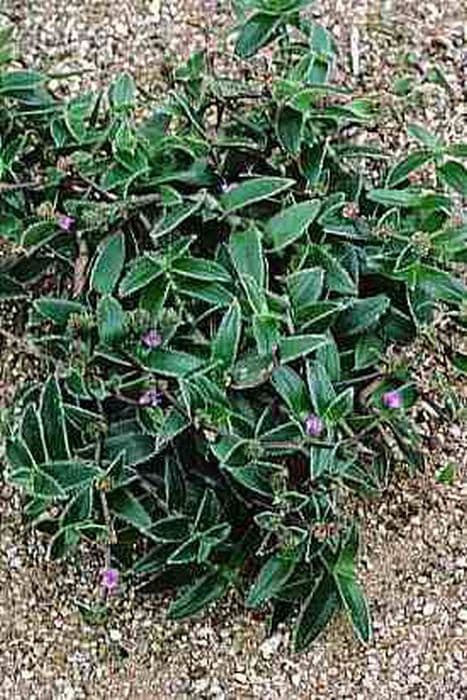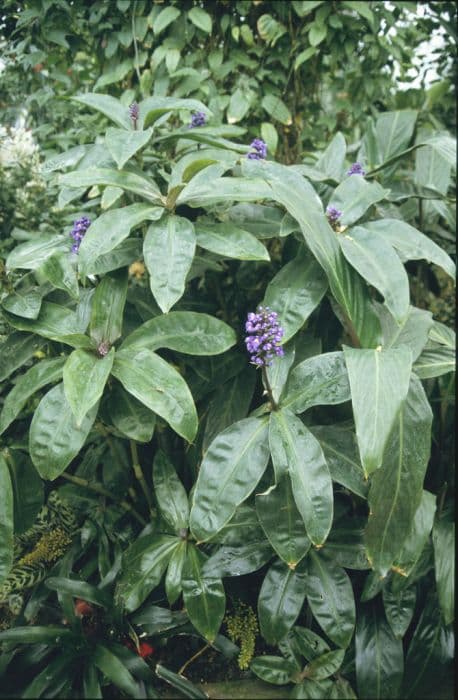Dayflower Commelina tuberosa Coelestis Group

ABOUT
The Commelina tuberosa, also known as Dayflower or Widow's Tears, is noted for its iconic blue flowers that resemble little three-petaled flags, two larger petals above with a smaller one below. The flowers boast a striking, vibrant blue hue which is often highlighted by a yellow center, giving them a cheerful, eye-catching appearance. These blooms cluster atop the lush, green foliage that is quite fleshy, characteristically reflecting light and appearing glossy. The leaves are narrow, elongated, and pointed, arranged in an alternating pattern on the stems, providing a dense, green backdrop that makes the flowers stand out even more. The stems are herbaceous, meaning they are not woody, and they tend to be succulent, which allows the plant to be relatively drought-tolerant. This verdant growth is accentuated with a delicate, almost succulent texture to the foliage, creating a soft, inviting aesthetic overall. Additionally, the flowers only open for a single day but are typically replaced by new blooms rapidly, ensuring a continuous display of color during the blooming season.
About this plant
 Names
NamesSynonyms
Dayflower, Widow's Tears
Common names
Commelina tuberosa Coelestis Group.
 Toxicity
ToxicityTo humans
The plant known commonly as 'dayflower' is not widely recognized as being toxic to humans. There is limited information about its toxicity, and it does not appear on major lists of poisonous plants. However, as with any plant, individual allergies or sensitivities may occur, and care should be exercised when handling unknown plants.
To pets
The 'dayflower' is not generally known to be toxic to pets. Similar to its effects on humans, there doesn’t seem to be significant evidence to suggest that this plant is dangerous to animals. Despite the lack of known toxicity, pets should still be discouraged from eating plants as they might cause gastrointestinal upset due to the animal being unaccustomed to digesting certain plant materials.
 Characteristics
CharacteristicsLife cycle
Perennials
Foliage type
Deciduous
Color of leaves
Green
Flower color
Blue
Height
1-2 feet (30-60 cm)
Spread
1-2 feet (30-60 cm)
Plant type
Herb
Hardiness zones
8
Native area
Mexico
Benefits
 General Benefits
General Benefits- Aesthetic Appeal: "Dayflower" adds vibrant blue flowers to gardens with its attractive star-shaped blooms.
- Draught Tolerance: The plant is able to withstand periods of low water availability, making it suitable for xeriscaping.
- Low Maintenance: Dayflower requires minimal care once established, which can save time and effort for gardeners.
- Rapid Growth: It has a fast growth rate, filling in garden spaces quickly and providing instant greenery.
- Erosion Control: The plant's dense foliage and root system can help stabilize soil and prevent erosion.
- Attracts Pollinators: The flowers attract bees and other pollinators, which are beneficial for the health of the garden and local ecosystem.
- Ground Cover: It can serve as an effective ground cover, reducing weed growth and covering bare spots.
- Easy Propagation: Dayflower is generally easy to propagate, allowing gardeners to create more plants for use or sharing with others.
- Edible Parts: Some parts of the plant are edible and can be used in salads or as a garnish, although this is not a primary benefit.
- Adaptability: It adapts well to a variety of garden settings, from full sun to part shade, and a range of soil types.
 Medical Properties
Medical PropertiesThis plant is not used for medical purposes.
 Air-purifying Qualities
Air-purifying QualitiesThis plant is not specifically known for air purifying qualities.
 Other Uses
Other Uses- As a natural dye: The blue flowers of the dayflower can be used to create a natural dye for fabrics, providing a range of blue hues.
- Edible flowers: The blossoms of the dayflower are edible and can be used in salads or as decorative garnishes on dishes, adding a subtle flavor and vibrant color.
- Ground cover: Due to its spreading habit, dayflower can be utilized as an effective ground cover in garden settings to suppress weeds and blanket bare spots.
- Children's educational tool: The ease of growing dayflower makes it an ideal plant for children's gardening projects, teaching them about plant growth and maintenance.
- Floral arrangements: Fresh or dried dayflower blooms can be used in floral arrangements for their striking color and unique form.
- Indicator of soil moisture: As dayflower prefers moist environments, its presence and health can be an indicator of soil moisture levels in a garden.
- Craft projects: Pressed dayflower flowers can be used in craft projects such as making bookmarks, greeting cards, or in decoupage arts.
- Photography subject: The distinct beauty of dayflower blooms, particularly the vivid blue petals, makes them a popular subject for garden photographers and artists.
- Insect habitat: Dayflower plants can provide habitat and nectar sources for beneficial garden insects like bees and butterflies.
- Companion planting: Dayflower can be planted alongside vegetables and fruits to attract pollinators, potentially enhancing the productivity of a home garden.
Interesting Facts
 Feng Shui
Feng ShuiThe Dayflower is not used in Feng Shui practice.
 Zodiac Sign Compitability
Zodiac Sign CompitabilityThe Dayflower is not used in astrology practice.
 Plant Symbolism
Plant Symbolism- Dayflowers: As a common name for Commelina tuberosa Coelestis Group, "Dayflowers" symbolize the ephemeral nature of life, reminiscent of the flowers that often last for only a day before wilting away.
- Transience: Reflecting on the short lifespan of the flowers, they can represent transience and the fleeting moments that should be cherished.
- Carpe Diem: Given their brief bloom period, dayflowers encourage the "seize the day" mentality, reminding us to take advantage of the present.
- Spontaneity: The sudden blooming and similarly rapid withering of the flowers suggest a spontaneous approach to life, taking things as they come.
- Adaptability: These plants often thrive in various environments, symbolizing adaptability and resilience in different life circumstances.
 Water
WaterThe Dayflower should be watered regularly, ensuring the soil is kept moist but not waterlogged. During the growing season, water it once every week with approximately one gallon of water, adjusting for rainfall and temperature conditions. In hot, dry periods, you may need to water twice a week. During the dormant winter months, reduce watering to every other week or less, depending on the dryness of the soil. Always check the top inch of soil for dryness before watering to avoid overwatering.
 Light
LightDayflowers thrive in bright, indirect sunlight. The ideal location would be in a spot where it receives morning sun and afternoon shade. However, it can also adapt to partial shade conditions, which means it should be fine if placed in a spot with filtered light throughout the day. Avoid exposing the plant to the harsh afternoon sun, especially in hot climates, as this can damage the leaves and flowers.
 Temperature
TemperatureDayflowers do best in temperatures ranging from 60 to 85 degrees Fahrenheit. They can survive minimum temperatures of around 40 degrees Fahrenheit, but frost can be harmful. Always protect the plant from extreme cold and avoid placing it in locations where temperatures could drop below the minimum threshold. The ideal temperature condition is a moderate one that does not fluctuate dramatically, mimicking its natural tropical habitat.
 Pruning
PruningPruning Dayflowers encourages bushier growth and prevents them from becoming leggy. Prune the plant in early spring before new growth begins. Remove any dead or damaged stems, and cut back up to one-third of the plant to maintain its shape and size. Pruning can be done again in late summer if necessary to remove spent flowers and stimulate new blooms.
 Cleaning
CleaningAs needed
 Soil
SoilDayflower thrives in fertile, well-draining soil with a pH of 6.0 to 6.5. A mix of loam, peat, and perlite works best for optimal growth.
 Repotting
RepottingDayflowers should be repotted every 2-3 years to replenish soil nutrients and accommodate root growth.
 Humidity & Misting
Humidity & MistingDayflower prefers moderate to high humidity levels, ideally between 60% and 70%.
 Suitable locations
Suitable locationsIndoor
Place Dayflower in bright, indirect light and maintain high humidity.
Outdoor
Plant Dayflower in partial shade with moist, well-drained soil.
Hardiness zone
9-11 USDA
 Life cycle
Life cycleCommelina tuberosa, commonly known as the Dayflower or tuberous wandering Jew, begins its life cycle as a seed, germinating in warm, moist soil where it rapidly develops roots and shoots. The seedling stage is characterized by the emergence of the first pair of true leaves which soon grow into a rosette form as the plant enters the vegetative stage. During the vegetative growth phase, the Dayflower produces thick, fleshy stems and additional leaves, all while developing a tuberous root system that allows it to store nutrients and water. As it matures, the Dayflower enters the flowering stage, typically in summer or early fall, where it produces clusters of vibrant blue or violet flowers that open for only a day. After pollination, the flowers develop into capsules containing seeds that, when mature, drop to the ground or are dispersed, thereby completing the reproductive stage. In colder climates, the plant may die back at the end of the growing season, but the tubers can remain dormant underground through winter, ready to sprout again with the return of favorable conditions, thus making the plant a perennial in some regions.
 Propogation
PropogationPropogation time
Spring to summer
Propogation: The Commelina tuberosa Coelestis Group, commonly known as the Dayflower, is typically propagated by division. The best time to carry out this method is in the spring, just as new growth begins to emerge. To propagate by division, first carefully dig up the plant, ensuring to keep a good amount of soil around the roots. Then, using your hands or a sharp knife, separate the tubers, each with a portion of roots and shoots, ensuring that each divided piece has at least one eye or growth point. Replant the divisions at the same depth they were originally growing in well-drained soil and water them thoroughly. These new plantlets should start to establish quickly with the arrival of warmer weather, leading to a successful propagation.
